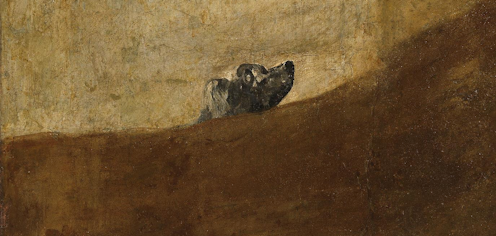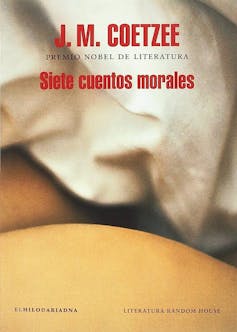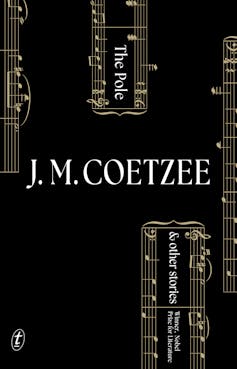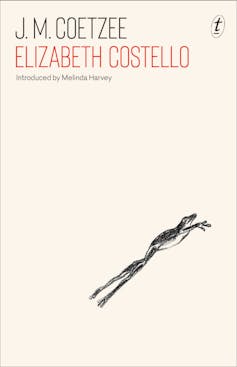
Devotees of J.M. Coetzee’s writing will be delighted at the publication of The Pole and Other Stories. What may be surprising to some about this collection is that the stories have all appeared before in some form – but not always in English.
The longest, The Pole, was first published in Spanish by an Argentinian press in 2022 as a standalone novella, El Polaco. It appears here in English for the first time.

This also applies to two other stories in the collection: Hope, which was originally published in Italian in 2019, and The Dog, first published in 2018 as El Perro in a Spanish-language edition of Coetzee’s stories titled Sietes Cuentos Morales (Seven Moral Tales).
This delayed publication in the anglophone world is deliberate. Coetzee has suggested he is interested in his work appearing in the Southern Hemisphere before it appears in the Global North. Allowing his writing to appear in translation first is a way of questioning the assumption that English is a dominant or “universal” language.
Access to these three stories alone makes the new publication worth reading, but this edition also includes three other stories originally published singly in English and collected here for the first time.
Review: The Pole and Other Stories – J.M. Coetzee (Text Publishing)
Elizabeth Costello
The collection’s six stories explore familiar Coetzeean themes of love, death, ageing, art and human-animal interaction. Although they are narrated in the third person, it is most often a woman’s perspective that drives the narrative.
Readers familiar with Coetzee’s work will recognise the fictional character of Australian feminist writer Elizabeth Costello in four stories: As a Woman Grows Older, The Old Woman and the Cats, The Glass Abattoir, and Hope.

In the last of these stories, Elizabeth has been diagnosed with early dementia. She summons her son John to Spain to be with her as she “does the business” of ending her own life. When John tries to persuade her that there is always hope of recovery, she replies, paraphrasing Kafka: “Yes, there is hope. But not for me.”
Elizabeth’s preoccupations in “the evening of her life” are more than ever with her own mortality, the notion of an afterlife, and her strong ethical views on animals.
The four stories in which she appears include conversations she has with John and her daughter Helen, who live in the United States and France respectively. As in Coetzee’s earlier book Elizabeth Costello (2003), these discussions are presented as “moral tales” or “lessons”, often in the form of stories within stories, whose ultimate meaning is debated or deferred.
The stories show that, as the human body becomes frailer, questions of the soul become more urgent.
Read more: Friday essay: 'All I am is literature' – Franz Kafka's diaries were the forge of his writing
The Pole
This body-soul relation is explored at greatest length in The Pole, the first and most substantial story of the collection (it takes up more than half of the book).

It begins with a male writer being pressured by two characters, a woman and a man, who “have been knocking at the door, wanting to be let in”. In the first four numbered sections, the writer sketches not only these characters’ physical appearances, as is traditional in a story, but poses questions about their souls. The rest is their story, presented in five numbered sections.
The narrative is set in Spain. Witold, an ageing Polish pianist who is a well-known interpreter of the music of fellow Pole Frédéric Chopin, is invited to play at a private concert in Barcelona. Beatriz, the Spanish society woman who is acting as his host, speaks no Polish and Witold speaks no Spanish. They communicate in English, in which Witold is not fluent, resulting in an awkward after-concert dinner, during which we are given Beatriz’s critique of Witold’s interpretation of Chopin – “so dry, so matter of fact!” as she says later.
Despite this unpromising brief encounter, Witold is smitten with the younger married woman. He believes her to be his “destiny”. The story traces their unusual relationship mainly from Beatriz’s viewpoint. She finds his fixation with her puzzling; his attempt to woo her through his music is “in a code she does not know how to read”.
Though Beatriz seems to pity the older maestro rather than to be physically or emotionally attracted to him, they have a sexual liaison on the island of Mallorca, reenacting an affair Chopin had with the French novelist George Sand in 1838. There are numerous other more subtle references to Chopin’s life in the story.
Echoing Dante’s love for Beatrice, Witold sees Beatriz as his muse, his angel and his goddess. He praises her modesty and grace. Beatriz drily describes this praise as “the whole creaking philosophical edifice of Romantic love”.
Yet Beatriz is somewhat shocked, after Witold’s death, to read the poetry he has written for her in Polish as a “record of love” to “woo her from beyond the grave”. She finds that it presents a version of love that is “coarse” rather than courtly, focused as much on the body as the soul.

Despite this, the poem she likes best is one in which a mother, bathing her young son (whom Beatriz assumes is Witold), educates him about the difference between male and female genitalia. This intimate mother-child scene and its discussion of body parts provides one of the story’s lighter, even amusing, moments.
Beatriz has the poems translated from Polish to Spanish by a woman translator who admits to having no ear for poetry. We, of course, read them in English, first in literal prose translation, then in more poetic form.
Initially, Beatriz is rather annoyed to be the subject (or object) of a man’s writing. “I never asked to be written about,” she comments.
There is an element here of the exploitative transaction between an artist and his reluctant muse, but Beatriz comes to see the poems as windows into Witold’s soul. She understands that, for him, she is a companion on his journey towards death, even though she is not physically with him – he is in Poland; she is in Spain.
Ironically, she writes to him only after he has died. In her final letter, she addresses him as “my prince”, and wishes him “good night” and “sweet dreams”, echoing Horatio’s moving farewell to the dead Hamlet: “Good night, sweet prince, and flights of angels sing thee to thy rest.” She belatedly assumes the role of an angelic figure accompanying Witold to the end of his life.
Animal-human interactions
The angel who helps the soul into the afterlife is a recurring and poignant motif. It appears too in The Old Woman and the Cats, where Elizabeth Costello prepares herself for her “last move” – her death and, perhaps, journey to an afterlife.
Elizabeth seems to have chosen an unlikely guide for this last journey: a local man named Pedro, the village “flasher”, who, like the feral cats she is sheltering, is someone whose “mode of being” is “more unlike” hers than her “human intellect” can comprehend. While her son John finds Pedro physically repulsive, Elizabeth sees him and the wild cats as possessing an intuitive intelligence that is superior to human logic and rationality. This gap between human thought and animal being is raised again in The Glass Abattoir and The Dog.

In The Glass Abattoir, Elizabeth’s encounter with a young man in Djibouti taking his goat to be slaughtered at the market and her experience of watching a film about an industrial chicken hatchery lead her to pose questions about human cruelty and animal feeling in the face of death. She imagines what effect it would have on humans if a glass abattoir were constructed in the middle of a city so we could all see what happens within it.
Repudiating various philosophers who have downplayed animal sentience, Elizabeth defines humans as a “murderous gang”. Her role as writer, she suggests at the end of the story, is to remember and record the suffering of these animals. “It is for them that I write,” she says.
In contrast, it is the animal who has power over the woman narrator in the collection’s brief final story, The Dog, in which a woman living in a French village cycles to work each day past a house where a large male dog terrorises her. She is aware she gives off a “humiliating smell of fear” that she is unable to control and gives the dog “the satisfaction of dominating her”.
The story ends with her facing the dog and cursing him “to hell”, standing up to what she sees as his male brutality – another example of the collection’s woman-centred perspective.
Read more: Peter Singer's fresh take on Animal Liberation – a book that changed the world, but not enough
An extraordinary literary legacy
The stories in this volume were written and rewritten across a wide span of years (2003–2022). They echo Coetzee’s major themes and satisfyingly represent the range and depth of his later fiction. In a recent interview, Coetzee looked back at his long writing career (as Elizabeth Costello does in several of these stories). In typically self-deprecating style, he summed up his achievements in this way:
After many years of practice, I believe I write good, simple, economical English sentences, with sufficient syntactical flexibility to make them attractive enough, from a musical point of view, to hold the reader’s attention.
The Pole and Other Stories is a timely reminder of Coetzee’s extraordinary literary legacy, which is so much more profound than this modest understatement would suggest. There has been an enormous amount of scholarship on his work and these stories provide a taste of why this is so.
Cotezee’s distinctive multi-layered narratives address big issues in a deceptively simple style that pays meticulous attention to the nuances and ambivalances of language itself. They invite many interpretations without confirming any. The publication of this collection is a welcome and significant tribute to this brilliant writer and, for readers new to his work, provides a gateway to one of the most important writers of our time.
Sue Kossew does not work for, consult, own shares in or receive funding from any company or organization that would benefit from this article, and has disclosed no relevant affiliations beyond their academic appointment.
This article was originally published on The Conversation. Read the original article.







